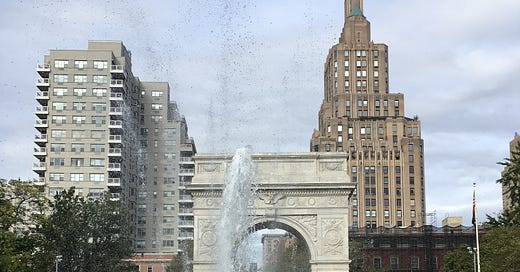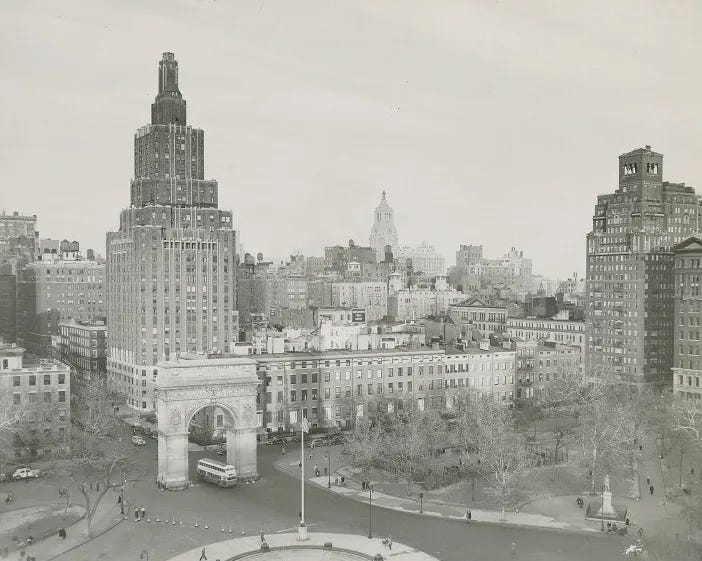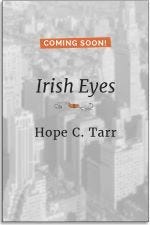I hope everyone had a wonderful Independence Day holiday, or as my sage pal Suzan Colón might say, “Interdependence Day.”
At this point, I’m blessed to have quite a few Fourth of Julys under my belt. There are the fond albeit fuzzy memories of being a young graduate student on the National Mall in DC, sun-baked and beer buzzed and stacked sardine-style amid a gaggle of friends, the day bookended by someone’s boozy house party on the Hill and the trek home on blistered feet to the nearest Metro train stop. (Good times but consider that particular box ticked).
In the mid-aughts, the Macy’s fireworks in New York City became home court, one year viewed from the deck of the Intrepid Museum at Pier 86 on the Hudson; otherwise, from our apartment building’s roof deck overlooking the East River. These days, the Asbury Park fireworks are our go-to, enjoyed while chilling on our preferred patch of Jersey Shore beach.
Reminiscing on Fourth of Julys gone by got me thinking about the public spaces in which we gather, to celebrate and commemorate our collective grand occasions, mourn our losses and sometimes to express our outrage.
But how much, or how little, do we really know about the hidden histories of these special spots?

Washington Square Park in Greenwich Village is one of my favorite New York City greenspaces. The imposing marble arch constructed to commemorate George Washington’s inauguration as the first U.S. president, the burbling central fountain, the buskers, the NYU students, the chess players hustling beneath a canopy of centuries’ old trees, the feeling of leaving Fifth Avenue and modernity behind and passing through a portal to a magical, mystical urban oasis — I love it ALL. (Okay, maybe I don’t exactly love dodging the skateboarders but otherwise it’s pretty great). And yet, beneath the buzz of activity and the profusion of flowers…
Washington Square Park is, among all its other lovely attributes, a cemetery.
Originally the city used the land as a potters’ field1 and a gallows for public executions.2 Into the early 1820’s, Minetta Creek3 ran just south of the park, flowing upwards to the area known today as Union Square. Unfortunately, overcrowding and poor sanitation made the stream a breeding ground for disease, especially yellow fever.4
In the summer of 1797, the city was hit with a particularly bad outbreak of yellow fever, a disease spread by the bite of an infected mosquito. Existing cemeteries quickly filled, and the city fathers looked north to bury the dead. By November 1797, the land had been pressed into service as a burial ground for the poor and unclaimed. Over the next twenty-eight years, more than 20,000 people would be laid to final rest here.
On July 4, 1826, the space was officially renamed “The Washington Parade Ground” to commemorate the fiftieth anniversary of the signing of the Declaration of Independence).5 The parade ground soon became known as Washington Square, esteemed for its patriotic associations and genteel society.6
By 1833, the area had risen considerably, as evidenced by the terrace of Greek Revival townhouses on the north side of the park known as The Row7. By then, public burials for the poor and indigent had been moved farther uptown to what is today Bryant Park.8
In 1870, Tammany Hall’s “Boss” William M. Tweed organized the first Department of Public Parks and set about transforming what was by then a shabby parade ground into a stylishly landscaped park.9
On March 25, 1911, horrified onlookers poured into the Park as fire tore through the Triangle Shirtwaist Factory, which occupied the top floors of the adjacent Asch Building at 23-29 Washington Place. (You can read more about the fire and its aftermath in my earlier post here).
The path through the famed Marble Arch, today the exclusive purview of perambulating pedestrians, remained a throughway for vehicles, horse-drawn and later horse-powered, into the twentieth century.
In 1958, two plans were put forth for a more established roadway through the park, extending Fifth Avenue to West Broadway. Robert Moses, then City Construction Coordinator, Slum Clearance Chairman, and Parks Commissioner, proposed four lanes 48 feet wide. A public hearing drew passionate protest as well as a counterproposal to exclude all vehicle traffic from the park. Preservation proponents included former first lady Eleanor Roosevelt,10 who kept an apartment at 29 Washington Square.
In 2005, the Landmarks Preservation Commission implemented a $16 million redesign of the park. The project (in)famously included replacing the original fountain with one that aligned with the Marble Arch.11 The waste and frankly, stupidity of this decision was still being discussed when I moved to the city in 2008.
As for those 20,000 buried bodies, including many uncovered when the former fountain was razed, the majority were left untouched. They, and their hidden histories, remain buried there to this day.
Next time on History With Hope, I’ll dive into the fascinating history of the Park’s anchor monument, the Marble Arch, specifically its brilliant and scandalous architect, Stanford White (1853 - 1906).
Share this free public post with other history lovers.
Not yet subscribed to History With Hope? You can fix that here!
The term “potters’ field” has its origins in the New Testament, referring to the “field of blood” purchased by the high priests of Jerusalem — with the coins, blood money, Judas was paid for betraying Christ — for use as a paupers’ burial ground. Prior to then, potters had come to the site to gather its rich, red clay for their ceramics.
The Post-Star. “Davis to Attend Oldest Fireman’s 100th Birthday.” 24 Feb. 1926, page 7. Extracted via newspapers.com.
Minetta Creek originated at Fifth Avenue and East 21st Street, with another branch flowing from the corner of Sixth Avenue and W. 16th Street. The creek ran through the grounds of Washington Square Park, along Minetta Place and Downing Street to the Hudson River. https://hiddenwatersblog.wordpress.com/2017/10/30/minetpk/
Folpe, Emily Kies. “History.” Washington Square Park Conservancy. https://washingtonsquareparkconservancy.org/history/
The Evening Post. “National Jubilee.” 29 June 1826, 2. Extracted via newspapers.com.
Folpe
Built in 1833, a terrace of 12 Greek Revival brick and marble townhouses on Washington Square North. Famous residents include several well-heeled literati including Edith Wharton, Willa Cather and the artist Edward Hopper (No. 3) who with his wife maintained a residence and studio here from 1913 until his death in 1967.
Today, the city maintains a potters’ field on Hart Island, the graves dug and maintained by inmates of nearby Rikers Island. Currently family members of the more than one million buried there as well as the curious can visit the grave sites only on certain days. No cameras or cellphones are allowed. There is an ongoing discussion about transferring oversight of Hart Island from the Dept. of Corrections to the Parks Service. https://www.nyc.gov/site/hartisland/index.page
Folpe
Lee, Harry, “Old Photos of Washinton Square. A Journey to the Analog Past,” NYU Local, https://nyulocal.com/old-photos-of-washington-square-a-journey-to-the-analog-past-8cb7fe3bcd06









What an interesting history.